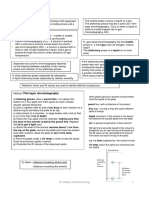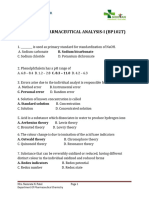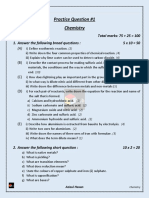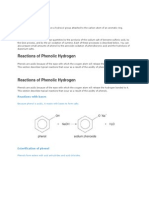2HPLC5667
2HPLC5667
Uploaded by
Jany SCopyright:
Available Formats
2HPLC5667
2HPLC5667
Uploaded by
Jany SOriginal Description:
Copyright
Available Formats
Share this document
Did you find this document useful?
Is this content inappropriate?
Copyright:
Available Formats
2HPLC5667
2HPLC5667
Uploaded by
Jany SCopyright:
Available Formats
1.
HPLC stands for
A.High Pressure Liquid Chromatography
B.High Performance Liquid Chromatography
C.both (a) and (b)
D
Highly Placed Liquid Chromatography
.
2. The eluent strength is a measure of
A.solvent adsorption energy
B.solvent absorption energy
C.solvent diffusivity
D
solvent mixing index
.
3. HPLC methods include
A.liquid/liquid (partition) chromatography
B.liquid/solid (adsorption) chromatography
C.ion exchange and size exclusion chromatography
D
all of the above
.
4. Column efficiency is measured in terms of number of plates which is
A.inversely related to the square of the peak width
B.directly related to the square of the peak width
C.inversely related to the cube root of the peak width
D
directly related to the square of the peak width
.
5. For a typical adsorbent such as silica gel, the most popular pore diameters are
A.10 and 50 A°
B.60 and 100 A°
C.100 and 150 A°
D
150 and 200 A°
.
6. An isocratic elution in HPLC is one in which the composition of the solvent
A. remains constant
B. changes continuously
C. Changes in a series of steps
D. none of these
7. In reversed phase HPLC, there is a
A. non polar solvent/polar column
B. polar solvent/non-polar column
C. non polar solvent/non-polar column
D. any of the above
8. Which of the following statements is true for a refractive index detector in HPLC?
A. It is more sensitive than a UV detector
B. It can only be used for isocratic elutions
C. It does not respond to many solutes
D. none of above
9. A gradient elution in HPLC is one in which the composition of the solvent
A. remains constant
B. is changed continuously or in a series of steps
C. both (a) and (b)
D. none of the above
10. An eluotropic series
A. ranks solvents by their relative abilities to displace solutes from a given absorbent
B. ranks column packing material by their relative abilities to retain solutes on the column
C. is a measure of the solvent adsorption energy
D. none of the above
11. Dwell volume is defined as
A. the volume of solvent contained in a liquid chromatographic column
B. the time required for the gradient to reach the column
C. the volume of the column between the point at which solvents are mixed and the
beginning of the column
D. none of these
12. Void volume refers to the
A. total volume of eluent in the column the remainder being taken up by the packing material
B. the volume of solvent contained in a liquid chromatographic column
C. the time required for the gradient to reach the column
D. the volume of the column between the point at which solvents are mixed and the beginning of
the column
13. In normal phase HPLC, there is a
A. non polar solvent/polar column
B. polar solvent/non-polar column
C. non polar solvent/non-polar column
D. any of the above
14. Which of the following(s) is/are the advantage of HPLC over traditional LPLC (low-pressure liquid
chromatography)?
A. Greater sensitivity and reusable columns
B. Ideal for ionic species and large molecules
C. Sample recovery
D. All of the above
15. Which can be used as a mobile phase in HPLC applications?
A. Any compound with solubility in liquid
B. Any compound with limited solubility in liquid
C. Any compound with non-solubility in liquid
D. Any of the above
You might also like
- Binomo Trading Strategies 009Document3 pagesBinomo Trading Strategies 009Jany S100% (2)
- MCQ in ChromatograpgyDocument25 pagesMCQ in ChromatograpgyDeepak Pradhan62% (63)
- O Level Biology Practice Questions And Answers EnzymesFrom EverandO Level Biology Practice Questions And Answers EnzymesRating: 5 out of 5 stars5/5 (1)
- Oil in Water Analysis: ISO 9377-2 / 9377-2 MODDocument5 pagesOil in Water Analysis: ISO 9377-2 / 9377-2 MODtaitelhocine4903No ratings yet
- Mcqs - Biochemistry - HPLC - PFMSG ForumDocument4 pagesMcqs - Biochemistry - HPLC - PFMSG ForumArslan Bashir75% (4)
- HPLC - GCDocument28 pagesHPLC - GCTayyaba Sadaq100% (1)
- Separation Final Merged - RemovedDocument112 pagesSeparation Final Merged - RemovedBisma ShafiqNo ratings yet
- Chromatographic Methods Part 2Document113 pagesChromatographic Methods Part 2hamidNo ratings yet
- QuestionsDocument17 pagesQuestionsAbhishek SunaNo ratings yet
- Analytical Stream Model QuestionsDocument4 pagesAnalytical Stream Model Questionsdanimiresa961No ratings yet
- DTL TestDocument11 pagesDTL TestHuma Hameed DogarNo ratings yet
- Assignment 1 PharmacognosyDocument2 pagesAssignment 1 Pharmacognosyfas.eehariaz1No ratings yet
- PPSC Exams Past Paper 10Document9 pagesPPSC Exams Past Paper 10Muhammad RawasNo ratings yet
- File 2Document6 pagesFile 2taiwoomolase53No ratings yet
- Multiple Choice QuestionDocument30 pagesMultiple Choice QuestionJayabrata DasNo ratings yet
- Solution PDFDocument5 pagesSolution PDFGourab SahaNo ratings yet
- Fe754 MCQ On Column ChromatographyDocument4 pagesFe754 MCQ On Column ChromatographyAalisha AyoobNo ratings yet
- Practice Problem Set 12 HPLCDocument12 pagesPractice Problem Set 12 HPLCYocobSamandrewsNo ratings yet
- FILE - 20220817 - 180854 - CÂU HỎI ÔN TẬP TACNCNTPDocument8 pagesFILE - 20220817 - 180854 - CÂU HỎI ÔN TẬP TACNCNTPHương LêNo ratings yet
- 22مراجعة التحليل الاليDocument15 pages22مراجعة التحليل الاليمحمود بلاسيNo ratings yet
- Pemisahan Problem Set TutorDocument3 pagesPemisahan Problem Set TutorPutriNurHamidahNo ratings yet
- PH Pharmacy Mcqs 638485325168690902Document199 pagesPH Pharmacy Mcqs 638485325168690902hly09812No ratings yet
- MCQ Solubility Chapter One 20220403Document31 pagesMCQ Solubility Chapter One 20220403سراج الدين علي وفيق علي100% (1)
- Mcqs - BiochemistryDocument3 pagesMcqs - Biochemistrynagendra_rdNo ratings yet
- 3.16 Revision Guide Chromatography AqaDocument3 pages3.16 Revision Guide Chromatography AqaRS JNo ratings yet
- Column Chromatography Questions - Docx 1Document7 pagesColumn Chromatography Questions - Docx 1Zeeshan AhmadNo ratings yet
- Sepapro - Quiz 4Document2 pagesSepapro - Quiz 4Ruel Arila Jr.50% (2)
- MCQ For Pharmaceutical Analysis-I (Bp102T) : Mrs. Namrata N. Patel Department of Pharmaceutical ChemistryDocument17 pagesMCQ For Pharmaceutical Analysis-I (Bp102T) : Mrs. Namrata N. Patel Department of Pharmaceutical ChemistryNamrata patelNo ratings yet
- HPLC - Part IDocument15 pagesHPLC - Part ISakhawat HossainNo ratings yet
- TY BSC SEM VI Analytical ChemistryDocument14 pagesTY BSC SEM VI Analytical ChemistryShahbaz Ahmed RanaNo ratings yet
- MCQ of Chapter - 1 and 2 Class XII ChemistryDocument14 pagesMCQ of Chapter - 1 and 2 Class XII Chemistrysanaulhaque38No ratings yet
- Holiday Home Work Xii A 2022-23 ChemistryDocument12 pagesHoliday Home Work Xii A 2022-23 ChemistryNitesh MehtaNo ratings yet
- ChemTech Board ExamsDocument11 pagesChemTech Board ExamsRecca DeocampoNo ratings yet
- HPLC 2009Document27 pagesHPLC 2009Arjun MaharajNo ratings yet
- Gradient HPLCDocument20 pagesGradient HPLCharoonjdasanNo ratings yet
- Chapter 28 Liquid Chromatography: (D) Reversed-Phase PackingDocument4 pagesChapter 28 Liquid Chromatography: (D) Reversed-Phase PackingElaine P.No ratings yet
- HPLC LectureDocument17 pagesHPLC LectureMani JeeNo ratings yet
- Colligative Properties ReviewerDocument1 pageColligative Properties ReviewerRugi Vicente RubiNo ratings yet
- CH 135 Exam II A KeyDocument6 pagesCH 135 Exam II A Keynguyen ba trungNo ratings yet
- Laboratory Apparatus and Equipment ReviewerDocument6 pagesLaboratory Apparatus and Equipment ReviewerHera VictrixNo ratings yet
- Part 14 Biopharmaceutics 1Document7 pagesPart 14 Biopharmaceutics 1Suhil AhmmedNo ratings yet
- Application of MachineDocument21 pagesApplication of MachineSengatan LebahNo ratings yet
- Org Chem 3Document16 pagesOrg Chem 3RENE SUSETTE ANN PONTILLASNo ratings yet
- Lecture 3Document31 pagesLecture 3Muhamad Gaddafi SamsudinNo ratings yet
- Simultaneous Spectrophotometric Determination of The PK of A Weak AcidDocument10 pagesSimultaneous Spectrophotometric Determination of The PK of A Weak Acidjoanne_blanco100% (1)
- Compiled Past Board Exam Questions: Licensure Examination For Chemical Technicians October 29, 2021Document15 pagesCompiled Past Board Exam Questions: Licensure Examination For Chemical Technicians October 29, 2021Jhema Mae Eco AguilarNo ratings yet
- Holiday Homework Class Xii-ADocument42 pagesHoliday Homework Class Xii-Ageetanjaliawasthi375No ratings yet
- 14 - Lab 14 - R-HPLC For Detn of CaffeineDocument7 pages14 - Lab 14 - R-HPLC For Detn of CaffeineHoang Huong TraNo ratings yet
- Lecture 8 - ExtractionDocument22 pagesLecture 8 - ExtractionNimit RiniNo ratings yet
- Determination of Aspirin in Analgesic Tablet by High Performance Liquid ChromatographyDocument4 pagesDetermination of Aspirin in Analgesic Tablet by High Performance Liquid ChromatographyRazel Elaine Grace CataluñaNo ratings yet
- Exit inDocument4 pagesExit inMegersa ChaliNo ratings yet
- CHM256 - Tutorial 7Document2 pagesCHM256 - Tutorial 7Fatimah AzzahrahNo ratings yet
- Sybpharm Sem Iii Physical Pharmacy I Practice Questions & Answer KeyDocument11 pagesSybpharm Sem Iii Physical Pharmacy I Practice Questions & Answer KeyMohd AzeemNo ratings yet
- Chemistry 141Document24 pagesChemistry 141Abdulsamad OyetunjiNo ratings yet
- Titration Work Sheet (1)Document4 pagesTitration Work Sheet (1)roblox codesNo ratings yet
- Anachem Le1Document4 pagesAnachem Le1Bernard Jomari Blancada RazoteNo ratings yet
- MassTransfer MCQSDocument44 pagesMassTransfer MCQSyaseenNo ratings yet
- 9 - Gas ChromatographyDocument114 pages9 - Gas ChromatographyParthrajsinh GohilNo ratings yet
- Chapter 2 Lle PDFDocument67 pagesChapter 2 Lle PDFMuhammad Farhan100% (1)
- Tutorial 7Document1 pageTutorial 7Asyraf RefdinNo ratings yet
- Q.2. Several Column Types (Can Be Classified As) : Q.1.What Affects System (HPLC)Document2 pagesQ.2. Several Column Types (Can Be Classified As) : Q.1.What Affects System (HPLC)Prema MowNo ratings yet
- 2nd List For Training 19 20 JanuaryDocument3 pages2nd List For Training 19 20 JanuaryJany SNo ratings yet
- New School Activities and DailyDocument9 pagesNew School Activities and DailyJany SNo ratings yet
- Educational Importance Aiou-UrduDocument271 pagesEducational Importance Aiou-UrduJany SNo ratings yet
- Binary Trading 1Document6 pagesBinary Trading 1Jany SNo ratings yet
- Binomo Article 08Document5 pagesBinomo Article 08Jany SNo ratings yet
- Electrophoresis GHHDocument9 pagesElectrophoresis GHHJany S100% (1)
- Human Physiology II MCQS66Document11 pagesHuman Physiology II MCQS66Jany S100% (2)
- 3 Blotting 6788Document3 pages3 Blotting 6788Jany SNo ratings yet
- Mcqs For Paper SciologyDocument14 pagesMcqs For Paper SciologyJany S80% (10)
- Developments in Epoxy Modified CementsDocument12 pagesDevelopments in Epoxy Modified Cementsb4rfNo ratings yet
- Soal Dan Jawaban UAS Pengantar Teknik Kimia 2012Document12 pagesSoal Dan Jawaban UAS Pengantar Teknik Kimia 2012shawn iceNo ratings yet
- Chemistry 101Document31 pagesChemistry 101slim_101No ratings yet
- Bioactive Materials: Presented By-Dr Kajal Bhayani Mds 1 YearDocument78 pagesBioactive Materials: Presented By-Dr Kajal Bhayani Mds 1 YearVidhi ThakurNo ratings yet
- Process Flow Sheets - Flow Chart SymbolsDocument6 pagesProcess Flow Sheets - Flow Chart SymbolsKHUSHI GUPTANo ratings yet
- Effect of The Waste Plastic Bottles On Properties of AsphaltDocument10 pagesEffect of The Waste Plastic Bottles On Properties of Asphaltd TjonasanNo ratings yet
- Aqa Planner 2024Document16 pagesAqa Planner 2024Abayomi Samuel LanreNo ratings yet
- OK Weartrode 62 (84.84)Document2 pagesOK Weartrode 62 (84.84)Dieng MessatsuNo ratings yet
- Recent Insight Into Enzymatic Degradation of Plastics Prevalent in The Environment A Mini - ReviewDocument8 pagesRecent Insight Into Enzymatic Degradation of Plastics Prevalent in The Environment A Mini - Reviewtiffany charlottaNo ratings yet
- Practice Question #1 ChemistryDocument2 pagesPractice Question #1 Chemistryazizul hasanNo ratings yet
- Pod66 Tang PDFDocument9 pagesPod66 Tang PDFM Jodi AlfayedNo ratings yet
- ME511 Slides1409Document176 pagesME511 Slides1409b20328No ratings yet
- Manufacture of Refractory Silica Bricks From Silica SandDocument16 pagesManufacture of Refractory Silica Bricks From Silica SandMeena YeasminNo ratings yet
- Experiment 3Document10 pagesExperiment 3Nisha Rata KarusanNo ratings yet
- Material Safety Data Sheet Suncut 1MDocument2 pagesMaterial Safety Data Sheet Suncut 1MDhani PriyambodoNo ratings yet
- Bản sao của ĐỀ SỐ 15Document6 pagesBản sao của ĐỀ SỐ 15Nguyễn LinhNo ratings yet
- Free-Radical Polymerisation (The FRP Mechanism) : Polymer SynthesisDocument9 pagesFree-Radical Polymerisation (The FRP Mechanism) : Polymer SynthesisNazratul NajwaNo ratings yet
- ToxicologyDocument8 pagesToxicologybernalhoneylethjhoy06No ratings yet
- Aldehyde Ketone PPT 2Document21 pagesAldehyde Ketone PPT 2muskan dahiyaNo ratings yet
- Cbse Test Paper-05: Science & Technology (Class-10) Chapter 4. Carbon and Its CompoundsDocument1 pageCbse Test Paper-05: Science & Technology (Class-10) Chapter 4. Carbon and Its CompoundsbannaduraiNo ratings yet
- Phenol SDocument9 pagesPhenol SAnonymous 8rsxG4No ratings yet
- IGCSE Chemistry Chemistry of ManufacturingDocument2 pagesIGCSE Chemistry Chemistry of ManufacturingdanielmahsaNo ratings yet
- 400 Q PDFDocument91 pages400 Q PDFAhmed FoudaNo ratings yet
- Ledeburite: Solidification of Cast IronsDocument14 pagesLedeburite: Solidification of Cast IronsFauzul ImanNo ratings yet
- Flame HardeningDocument2 pagesFlame Hardenings_manikandanNo ratings yet
- SGS Speeds Feeds 135 3D MetricDocument2 pagesSGS Speeds Feeds 135 3D MetricPuneeth KumarNo ratings yet
- POGIL Types of Chemical ReactionsDocument7 pagesPOGIL Types of Chemical ReactionsLeonardo AlvarezNo ratings yet
- Chemistry Investigatory Project XII On Toothpaste AnalysisDocument30 pagesChemistry Investigatory Project XII On Toothpaste AnalysisSoul ViperNo ratings yet
- AyushDocument19 pagesAyushgourang asatiNo ratings yet



































































































